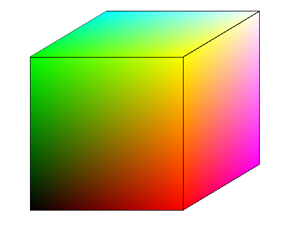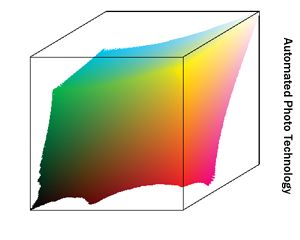Color Space Page 3
Now, envision that that cube has within it a bubble (see illustration, lower right), that bubble representing all colors which can be printed with a garden-variety (nothing special) color printer. We could make the statement that the colors within that "bubble" are more important than the colors outside the bubble. The colors within the bubble are less than 1/3 of all possible colors in the cube, so that makes this statement regarding important colors even stronger.
Now we come to an important reality: the cube doesn't need to be linear. Envision a contraction (a warping) of the data space, so within the bubble steps are smaller, and outside the bubble steps are larger. (You've heard of thinking outside the box. This is thinking outside the bubble.) Before we did this, there were 16,777,216 colors in the cube. After we do this, there are still 16,777,216 colors in the cube. And the range of colors that are in gamut hasn't changed. Any color that was just barely out of gamut before is still just barely out of gamut now. The bubble is exactly the same size and shape. However, our way of describing the colors has changed. A single step within the bubble is less likely to be discernable to the eye than it was, before. And, a single step outside the bubble is more likely to be discernable to the eye. However, if our intent is to make a print, those colors are going to have to be translated to in-gamut colors for printing anyway, so that's not as much of a concern.
The primary difference between the Adobe 1998 color space (commonly the result of editing in Photoshop) and the sRGB color space (the color space produced by many if not most digital cameras) is that the Adobe 1998 color space has more warping of the data space, to provide more unique data values within the bubble (in gamut), at the expense of fewer data values outside the bubble (out of gamut).

